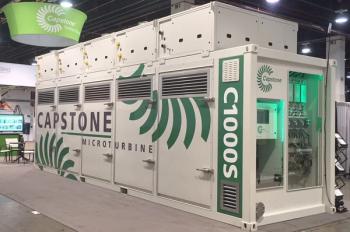
RENEWABLES ARE TAKING MARKET SHARE FROM GAS TURBINES
By Mark Axford
Between 1981 and 1985, a great many gas turbines (GTs) were sold in the U.S. The incentive was a federal tax credit and depreciation subsidy for certain types of investments. This subsidy was not provided exclusively for power plants or for gas turbines, but it helped developers building independent power plants to compete with the established regulated utilities. When GE launched the LM6000 gas turbine in 1990, it was the perfect PURPA machine: A 40% efficient GT that could meet the efficiency requirements of the Public Utility Regulatory Policy Act with a steam load of less than 10,000 lbs/ hr. A developer could build a 50 MW “Qualified Facility” eligible for long-term power purchase agreements with favorable commercial terms. By the end of 1998, 49 LM6000s had been ordered for projects in the U.S. The federal tax credit and depreciation subsidy died in 1986 and PURPA was essentially repealed in 2005 with the evolution of Independent System Operator (ISO) markets.
Wind and solar power were also part of the PURPA bandwagon in the 1980s, but did not gain their legs until a new subsidy, the production tax credit (PTC), was introduced. The PTC for wind and biomass power was enacted in 1992 and was scheduled to expire on July 1, 1999. Tax credits Since 1999, the PTC has been extended nine times. Additionally, a new 30% investment tax credit (ITC) was enacted in 2005 for solar power. On four occasions, the PTC and ITC were allowed to lapse before being retroactively extended. The PTC and ITC expired again in 2015 and were extended during December of 2015 as part of a federal budget compromise.
Such subsidies, however, are having a negative impact on GT orders and this will become more pronounced in the coming years. A PTC extension for wind power through 2020 and an ITC extension for solar power through 2022 are now in place by law. That budget compromise permanently cancelled an oil export ban that had been in place since 1975, set the rates of ITC and PTC credits for several years to come and can be looked upon as an indirect tax on carbon. So even with natural gas prices at $2.50 or less in many regions of the U.S., small and midsize GT power plants will find it more difficult, if not impossible, to compete with wind and solar.
Bloomberg analysis says that these wind and solar subsidies will create 37,000 MW of additional renewable generation. Another way to look at it is that this is generation that otherwise would have been mostly gas turbine powered. To put this into perspective, new orders for GTs in the U.S. have averaged about 8,000 MW per year during the last five years. In short, the 37,000 MW extended subsidy for wind and solar between 2016 and 2021 equates to about 80% of the U.S. market for gas turbines over that same period.
The nonpartisan Joint Committee on Taxation estimates that extending tax credits for wind power will cost taxpayers $14.5 billion, while continued solar tax credits will cost $9.3 billion. The day after the subsidy extension was passed into law, the stock price of SolarCity, the largest U.S. solar installation company, went up by 35%. If all these subsidies on the federal level were not enough, an additional subsidy is beginning to show up at the state level known as energy storage. This term effectively means battery storage — a technology being promoted to help improve the economics of wind and solar power. Without a doubt, economical battery storage is the holy grail of wind and solar power and the cost per MWH of storage capacity is indeed falling. During 2013, California mandated its investor owned utilities to install 1,325 MW of energy storage by 2021 and pass along the costs to the ratepayers. The cost of this subsidy has no upper value as long as the utilities can demonstrate that they shopped prudently for the mandated storage capacity. Other states and municipalities are evaluating similar mandates and other incentives for battery storage.
But what about the fact that many experts predicted an increase in orders for simple cycle peaking gas turbines as additional solar and wind power were connected to the grid? Getting back-up power While this sounds logical at first, grid managers are finding other ways to get the back-up power and ancillary services by ramping up and down the existing fleet of combined cycle power plants and by peak demand-reduction programs.
Therefore, unless these renewable and battery subsidies are adjusted downward or incentives are created for gas turbine power plants to balance the grid, the quantity of gas turbines ordered in the U.S. during the next 5 years will be substantially reduced. As a result, Axford Turbine Consultants is forecasting a 10% drop in gas turbine orders in the U.S. during 2016.
Newsletter
Power your knowledge with the latest in turbine technology, engineering advances, and energy solutions—subscribe to Turbomachinery International today.





